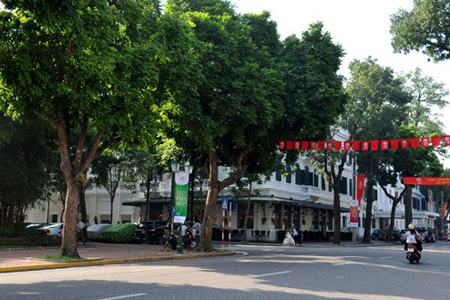Ngo Quyen street, Ly Thai To, Trang Tien and Hang Bai ward, Hoan Kiem district, Hanoi, Vietnam.
It’s 1,2km long, from runs from Hang Voi to Ham Long street, cuts Ly Thai To, Le Lai, Trang Tien, Hai Ba Trung and Ly Thuong Kiet street. The house number 12 on this street is Northern Palace, in which President Ho Chi Minh lived and worked after the August Revolution. Before the August Revolution, it was Governor of Tonkin’s Palace. Nowadays, it is Government Guesthouse.
Another road with same name is located in Quang Trung ward, Ha Dong district, Hanoi, Vietnam.
It’s 1,5km long, from Am bridge at the intersection point of Van Phuc and Chu Van An road, runs along northern side of La Khe canal until Cau Ngoi dormitory.
Ngo Quyen (899 – 944), born in Duong Lam village, Son Tay. He was a Vietnamese prefect and general during the Southern Han Dynasty occupation of Giao Chau in the Red River Valley in which is now northern Vietnam. In 938, he soundly defeated the Chinese at the famous Battle of Bach Dang River, north of modern Haiphong and ended 1,000 years of Chinese domination under the Han Dynasty. After overthrowing the Chinese government in Vietnam and founding the Ngo Dynasty – arguably the first Vietnamese feudal dynasty, Ngo Quyen transferred the capital to Co Loa, the capital of Au Lac Kingdom. From this time, Ngo Quyen reclaimed Vietnamese independence and was proclaimed as King (Ngo Vuong) of An Nam in 939. He named Vietnam Dai Viet when he was king.

